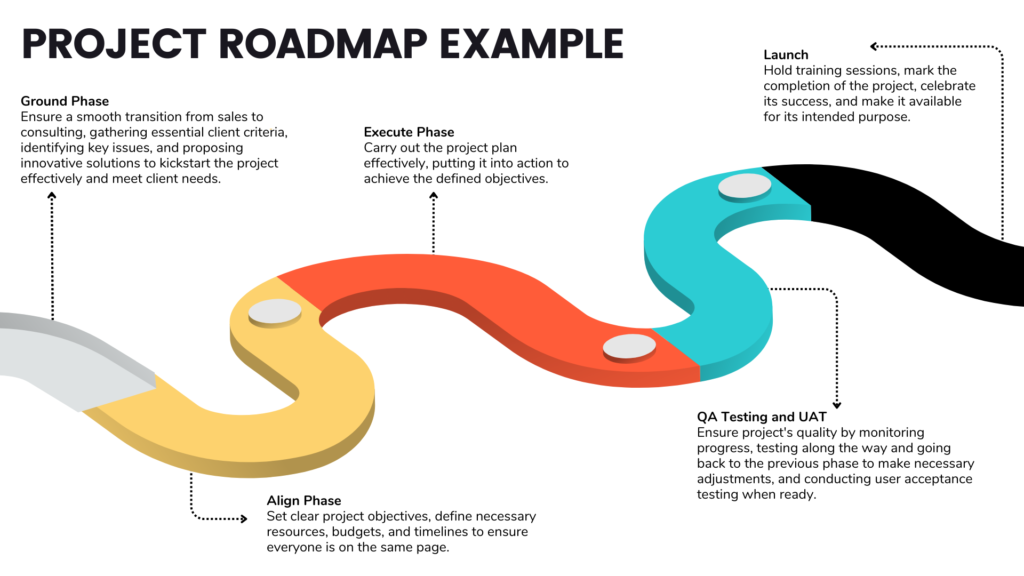When it comes to building out projects for business success, roadmaps act as invaluable guides, ensuring the timely, budget-conscious, and high-quality delivery of projects. This rings especially true when the project itself entails the construction and optimization of RevOps systems.
Consider, for a moment, attempting to build a house without a solid foundation or baking a cake without a tried-and-true recipe. In the context of project management, roadmaps are akin to these essential elements, providing a clear and structured route to project goals and successful outcomes. While having well-defined objectives is undeniably crucial, it’s equally vital that stakeholders executing the project are equipped with clear standards and the necessary resources to not only steer them in the right direction but also keep them on course.
Roadmaps play the pivotal role of ensuring that all involved parties are aligned, continuously working toward shared objectives throughout the project’s lifecycle. They serve as a bird’s-eye view of the project, complete with well-defined milestones, deliverables, and precise timelines.
Within the realm of roadmapping, strategy takes centre stage. At Lane Four, we’ve embraced the notion of adhering to a sequence of phases, signalling the importance of having milestones within project management playbooks. Through the careful construction of a roadmap that seamlessly aligns with the project’s strategic direction, we can prepare and be confident that every step is both calculated and purposeful.
The Phased Approach to Project Roadmapping
In project management, following phases is helpful, especially when the project entails many moving pieces, focuses, and stakeholders. It breaks a large, desired future outcome into smaller parts, cutting through the overwhelm and challenges in a more manageable way. A well-defined roadmap should encompass key phases that guide the project from inception to completion.

Our strategy at Lane Four is rooted in certain phases, ensuring that every step is meticulously planned and executed. This not only maintains the project’s integrity but also keeps stakeholders informed and engaged throughout the journey. Take a CPQ implementation breakdown as an example. While this type of project, like many others, may have different layers of execution, clarity in specific goals, timelines, budgets, and stakeholders should be carefully planned out and communicated regularly; especially when the tasks require the team to pivot at certain points.
In addition to utilizing phases to guide our project milestones, we follow a lean approach when it comes to stakeholder involvement. What does this mean? We believe that sometimes, less can be more, providing team members with a unique opportunity to view different aspects of the project. Consequently, we avoid over-resourcing our projects with an excess of team members. This approach not only streamlines project execution but also affords others the opportunity to learn new things, gain hands-on experience, and cultivate a versatile skill set throughout the project’s life cycle.
The Role of Testing in Project Roadmapping
Testing is the quality assurance checkpoint on the project roadmap. It’s also the proactive step that prevents costly setbacks and ensures that the end product meets or exceeds expectations. However, leaving testing until deployment is like discovering a structural flaw in your building after it’s already standing. To mitigate this, we recommend integrating testing exercises throughout the project’s roadmap; at least during building or execution phases. This approach of weaving testing throughout the build minimizes risks and helps in delivering a product that’s not only functional but also well refined.
Checklists! Checklists! Checklists!
Whether it’s a list of tasks, task requirements, or quality checks, meticulously crafted checklists ensure that nothing falls through the cracks. These simple yet invaluable tools keep everything in check, ensuring that no detail is overlooked, tasks are executed with precision, and similar tasks are completed in a consistent manner across the company. They act as the framework for maintaining project order, fostering efficiency, and providing a standardized structure that keeps all stakeholders on the same page.
Furthermore, checklists not only ensure that critical tasks are completed but also allow for creative and innovative thinking—it’s important this is taken into consideration when creating checklists for the first time. By establishing a reliable foundation of essential steps and requirements, they should also liberate project teams to explore new ideas and solutions without the fear of missing vital details. In essence, checklists strike a balance between maintaining the project’s rigour and providing the space for creative problem-solving, making them indispensable tools while moving through the roadmap.
When creating these resources for the first time, it’s valuable to engage leaders with diverse expertise, each representing a different facet of a project, thus guaranteeing checklists that encompass the entire project from all angles. To enhance adoption and promote consistency, it’s imperative to make your company’s checklists easily accessible, shared across the team, and accompanied by clear naming conventions.
Project Status Updates
Communication is the lifeblood of a successful project and regular project status updates provide the much-needed transparency to keep all stakeholders informed and engaged. Especially during periods where meetings may not happen as frequently, having a single place for both internal and external stakeholders to stay updated is invaluable. Whether it’s a shared Google document, a well-organized spreadsheet, or dedicated project management software, this unified approach not only streamlines the flow of information but also promotes efficiency and accountability.
It serves as a reliable hub where team members can access real-time progress reports, reference and discuss any roadblocks, and celebrate milestones, thus fostering collaboration and maintaining project momentum, even when stakeholders may enter or exit at various stages of the project roadmap.
The Importance of Continuous Improvement
In the world of project management, stagnation is the enemy of progress. Continuous improvement is the driving force behind success, and it begins with retrospection. Making appropriate modifications as part of the retro process and reflecting on what’s working and what needs improvement is an ongoing journey. At Lane Four, we believe in the power of learning from our experiences and making adjustments to our project management processes. This not only ensures that we stay at the forefront of industry best practices but also allows us to better serve our clients.
We believe successful project management demands precision, consistency, expertise, and a commitment to high quality execution. A successful project begins with a clear roadmap, which acts as the guiding star, lighting the path to successful project launches and deployments. By following milestone phases, integrating testing, utilizing checklists, maintaining regular project status updates, and embracing continuous improvement, businesses can ensure that the intricacies of project management remain well-managed and organized. Embracing these strategies ensures that projects stay on track, mitigates risks, and paves the way for continuous growth and refinement. Eager for more insight on what a roadmap would look like for your business? Let’s chat.
